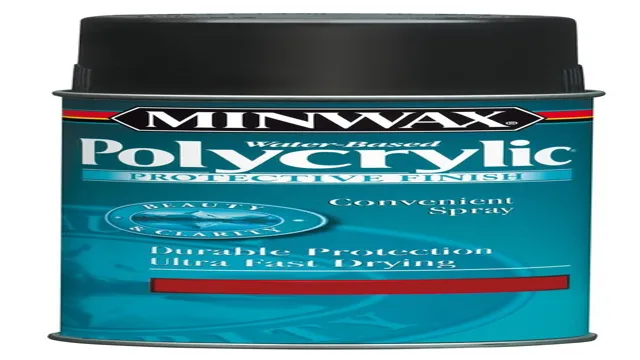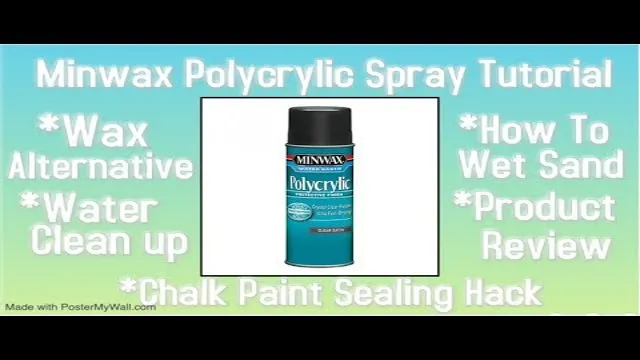If you’re looking to add a layer of protection to your wooden furniture, decors, or cabinets, using Minwax Polycrylic is a great choice to make it happen. But, have you considered spraying it? Spraying Minwax Polycrylic provides a smooth and even finish that brushing may not necessarily achieve. However, as with any spraying technique, it takes careful consideration and proper execution to get desirable results.
In this blog, we will dive into some tips and techniques that can help you achieve professional-looking results when spraying Minwax Polycrylic on your next DIY project. From what equipment to use to how to prep the surface and apply the spray, we’ve got you covered. So, let’s get started and take your woodworking projects to the next level.
What is Minwax Polycrylic?
Yes, you can spray Minwax Polycrylic, and it’s a great option for DIY enthusiasts who are looking to add a protective layer to their project. Polycrylic is a water-based protective finish that can be used on wood, metal, plastic, and more. It dries clear, so it won’t alter the color of your project, and it’s available in matte, satin, semi-gloss, and high-gloss finishes, so you can choose the level of sheen you prefer.
Spraying Minwax Polycrylic can be a bit tricky, though, as it’s important to apply thin, even coats to avoid drips and bubbles. A high-quality sprayer and a steady hand can result in a smooth and flawless finish.
Description and properties
Minwax Polycrylic is a water-based, clear protective varnish that is commonly used for finishing woodwork. It offers excellent durability and resistance to scratches, stains, and fading. It is also low odor, dries quickly, and cleans up easily with soap and water.
Additionally, it is non-yellowing, making it ideal for use on light-colored woods. Unlike other varnishes, Minwax Polycrylic does not require any special solvents or thinners for cleanup. Its versatile properties make it an excellent choice for multiple DIY projects, including furniture, cabinets, and flooring.
So if you’re looking for a high-quality, easy-to-use, and eco-friendly varnish for your woodworking projects, Minwax Polycrylic should definitely be on your list!

Advantages and disadvantages
Minwax Polycrylic is a water-based protective coating that is commonly used to protect and seal wooden surfaces. Its main advantage is that it dries faster than oil-based sealers and produces less odor during application, making it a popular choice for indoor projects. It also does not turn yellow over time, like some oil-based sealers can.
On the other hand, one disadvantage of using Minwax Polycrylic is that it can be more difficult to apply than oil-based sealers, as it can leave brush marks or bubbles if not applied properly. It can also be less durable than oil-based sealers, particularly in high-traffic areas. To achieve the best results, it is recommended to apply multiple coats and sand in between each coat to ensure a smooth and even finish.
All in all, Minwax Polycrylic can be a great option for those looking for a fast-drying, low-odor sealer for their indoor wooden projects, but it may not be the best choice for more high-traffic areas that require a more durable finish.
Can You Spray Minwax Polycrylic?
“Can you spray Minwax Polycrylic?” is a frequent question from those who want a durable and protective finish for their wooden projects. The answer is yes! You can definitely spray Minwax Polycrylic, but you have to follow some essential steps to ensure the best results. First of all, make sure the surface is clean and dry, and there’s no dust or debris.
Then, you should sand the wood with a fine-grit sandpaper to smooth the surface and create small scratches that will aid in adhesion. After that, you need to mix the polycrylic and use an HVLP spray gun, combined with a compressor for a fine mist that ensures even coverage. Keep the spray gun 6 to 8 inches away from the wood surface and start spraying with a sweeping motion.
Make sure to apply light coats and let them dry thoroughly before applying another layer. With the right technique, spraying Minwax Polycrylic can result in a smooth and beautiful finish for your project that will protect it for years to come.
Spraying equipment needed
If you’re considering spraying Minwax Polycrylic, you’ll need the right equipment to achieve a smooth finish. Spraying Polycrylic requires a high-quality sprayer capable of administering a fine mist of the product without clogging or dripping. Using an airless sprayer with a compatible tip size of 0.
011 to 0.015 inches is highly recommended. Additionally, you must wear protective gear, including a respirator, goggles, and gloves, to avoid inhaling fumes and avoid contact with your skin.
Before spraying the Polycrylic, make sure to prepare your surface appropriately, removing any old finish and sanding it down to a smooth finish. Once it’s ready to spray, use slow, even strokes to apply the product. Using short bursts of spray can help ensure the product goes on evenly and prevents runs.
With the right equipment and technique, you can spray Minwax Polycrylic and achieve a beautiful finish on your project that lasts for years to come.
Preparation steps
If you’re wondering whether or not you can spray Minwax Polycrylic, the answer is yes! However, there are a few key steps you need to take to ensure that your project turns out perfectly. First, it’s crucial to properly prepare the surface you’ll be spraying. This means cleaning it thoroughly and lightly sanding any rough areas.
Next, make sure you have all the necessary equipment, including a good quality sprayer and a well-ventilated area to work in. It’s also advisable to wear protective gear, such as a mask and gloves, to avoid inhaling any harmful chemicals. When you’re ready to begin spraying, be sure to shake the can well and test it out on a scrap piece of material first to get the hang of the technique.
Overall, with a bit of preparation and care, spraying Minwax Polycrylic can be an effective and efficient way to get a professional-looking finish on your woodworking projects.
Spraying techniques
Yes, you can spray Minwax Polycrylic. In fact, spraying is one of the best techniques to use when applying this finish. To ensure a smooth and even application, it’s important to use the right spray equipment and follow the manufacturer’s instructions carefully.
One of the key benefits of spraying is that it allows for quicker coverage and ensures that the finish dries evenly. However, when using a sprayer, it’s important to be mindful of overspray and to protect surrounding areas from accidental misting. Overall, spraying Minwax Polycrylic can be a great option for achieving a flawless finish on your woodworking project.
Tips for Achieving a Smooth Finish
“Can you spray Minwax Polycrylic?” Yes, you can! But it’s important to note that using a spray gun to apply Polycrylic can be a bit tricky. To achieve a smooth finish, it’s essential to choose the right spray tip and maintain the proper distance from the surface. You’ll also want to ensure that you’ve adequately prepared the surface, removing any dust or debris before spraying.
Additionally, spraying multiple thin coats will help prevent runs and drips, resulting in a flawless finish. And remember, practice makes perfect! Take your time and experiment with different techniques to find what works best for you. Ultimately, with a bit of patience and persistence, you can achieve a beautiful, professional-grade finish with Minwax Polycrylic applied via spray gun.
Sanding between coats
When it comes to achieving a smooth finish on your woodworking project, sanding between coats is an essential step. Not only does it help to remove any imperfections and roughness from the previous layer, but it also helps the next coat to adhere properly. But how do you go about sanding between coats without ruining all your hard work so far? Firstly, make sure you use the correct grit sandpaper.
Too coarse and you’ll create scratches, too fine and you won’t remove enough. A 220 grit is a good middle ground. Make sure to wipe away any dust between sanding and apply the next coat only when the previous one is completely dry.
Repeat the process until you achieve the smooth finish you desire. Remember, take your time and be patient – your final result will be worth it.
Using a dust collector
Using a dust collector is an essential step for achieving a smooth finish on your woodworking project. A dust collector helps to keep your workspace clean, your air quality high, and it prevents wood dust from ruining your finish. One important tip is to ensure that you follow the manufacturer’s instructions when setting up your dust collector.
It’s also important to regularly check and clean the collector bag to prevent clogging and to maintain its efficiency. Another key point is to position the collector at a point where it’s most effective for collecting dust. This typically means placing it as close as possible to the source of the dust.
Making use of a dust collector may seem like an added expense, but it’s well worth the investment in the long run. Not only does it contribute to a safer and healthier environment in your workspace, it also helps to achieve a clean and professional finish on your project.
Conclusion
In conclusion, asking if you can spray Minwax Polycrylic is like asking if you can fly a plane without a pilot’s license – technically, you can do it, but it’s not recommended. Sure, you may get lucky and have a beautiful finish on your project, but the likelihood of a disaster is high. So, unless you have experience with spray guns and a well-ventilated area, stick to using a brush or roller for applying Minwax Polycrylic.
Your project (and potentially your safety) will thank you.”
FAQs
1. What is Minwax Polycrylic?
Minwax Polyclyric is a water-based protective finish that is commonly used on furniture, woodwork, and other DIY projects.
2. Can Minwax Polycrylic be sprayed?
Yes, Minwax Polycrylic can be sprayed, but it is important to follow the manufacturer’s guidelines and use the correct equipment.
3. How do I prepare the surface for Minwax Polycrylic?
The surface must be clean and free of any dirt, grease, or wax before applying Minwax Polycrylic. Sand the surface with 220-grit sandpaper and wipe it down with a tack cloth.
4. Can Minwax Polycrylic be applied over stained wood?
Yes, Minwax Polycrylic can be applied over stained wood, but it is recommended to use a water-based stain for best results.
5. How many coats of Minwax Polycrylic should I apply?
It is recommended to apply at least two coats of Minwax Polycrylic, allowing each coat to dry completely before applying the next.
6. How long does it take for Minwax Polycrylic to dry?
Minwax Polycrylic typically dries to the touch in 30 minutes and can be recoated in 2-4 hours.
7. Can Minwax Polycrylic be used on outdoor projects?
No, Minwax Polycrylic is not recommended for outdoor use and may not hold up well in extreme weather conditions.






